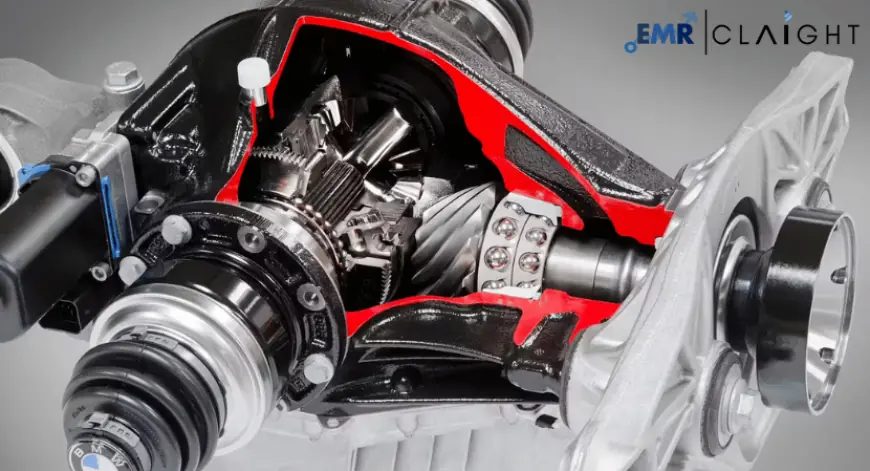The global automobile limited slip differential (LSD) market is projected to experience significant growth, with a Compound Annual Growth Rate (CAGR) of 5.3% from 2025 to 2034. This anticipated expansion underscores the growing demand for advanced automotive systems that enhance vehicle performance, safety, and driving dynamics. In this comprehensive analysis, we will delve into the factors driving the growth of the LSD market, market trends, regional insights, and emerging opportunities. Additionally, the discussion will consider major players shaping the market landscape, including American Axle & Manufacturing, Inc., BorgWarner Inc., Dana Incorporated, Eaton Corporation PLC, Hyundai Wia Corporation, and others.
Understanding the Limited Slip Differential (LSD)
A limited slip differential (LSD) is an automotive component that plays a crucial role in distributing torque between a vehicle's wheels. Unlike an open differential, which splits torque equally between wheels regardless of traction conditions, an LSD adjusts torque distribution to optimize traction and stability. This makes LSDs essential in high-performance, off-road, and even everyday driving conditions.
Get a Free Sample Report with Table of Contents@https://www.expertmarketresearch.com/reports/automobile-limited-slip-differential-market/requestsample
Types of Limited Slip Differentials
-
Mechanical LSD: Relies on clutch packs or helical gears to regulate torque distribution.
-
Viscous LSD: Uses a silicone-based fluid that thickens under heat, enhancing torque distribution during wheel slip.
-
Electronic LSD (e-LSD): Employs sensors and electronic controls to actively manage torque distribution.
Each type has distinct advantages and is tailored to specific vehicle applications, ranging from passenger cars to heavy-duty trucks.
Market Drivers and Growth Factors
1. Rising Demand for High-Performance Vehicles
The growing popularity of sports cars and performance vehicles is a major driver of the LSD market. High-performance vehicles require advanced differential systems to handle increased torque and provide superior handling.
2. Increasing Adoption in Off-Road and Utility Vehicles
Off-road vehicles, such as SUVs and trucks, benefit significantly from LSD technology, which ensures better traction on uneven or slippery terrains. As demand for SUVs and utility vehicles rises globally, so does the demand for LSD systems.
3. Enhanced Focus on Vehicle Safety and Stability
Governments and regulatory bodies are increasingly emphasizing vehicle safety standards. LSD systems contribute to better stability and control, particularly in adverse driving conditions, aligning with these safety requirements.
4. Technological Advancements in Automotive Systems
Innovations in electronic LSDs (e-LSDs) are driving market growth. These systems offer precise control and integration with other vehicle systems, such as electronic stability control (ESC) and anti-lock braking systems (ABS), enhancing overall vehicle safety and performance.
5. Growing Automotive Production in Emerging Markets
The expansion of the automotive industry in regions like Asia-Pacific and Latin America is a key growth driver. These regions are witnessing increased demand for vehicles equipped with advanced features, including LSD systems.
Challenges in the LSD Market
1. High Production Costs
LSD systems, particularly advanced e-LSDs, involve significant manufacturing costs. This can increase vehicle prices, potentially limiting adoption in cost-sensitive markets.
2. Competition from Alternative Technologies
Emerging drivetrain technologies, such as torque vectoring and advanced stability systems, may pose competition to LSD systems.
3. Limited Awareness Among Consumers
While LSD systems offer clear benefits, many consumers remain unaware of their advantages, especially in developing regions.
Market Trends and Opportunities
1. Integration with Electric Vehicles (EVs)
As the automotive industry shifts towards electrification, LSD systems are being adapted for use in electric and hybrid vehicles. The ability to enhance torque distribution in EVs can significantly improve performance and efficiency.
2. Growing Popularity of e-LSDs
Electronic LSDs are gaining traction due to their superior performance and integration capabilities. The adoption of e-LSDs is particularly prominent in luxury and high-performance vehicle segments.
3. Expansion of Aftermarket Services
The aftermarket for LSD systems presents significant opportunities. Consumers are increasingly upgrading their vehicles with advanced LSD systems for improved performance and safety.
4. Increased R&D Investment
Leading automotive component manufacturers are investing heavily in research and development to innovate and enhance LSD technology. This includes advancements in materials, design, and integration with autonomous driving systems.
Regional Insights
1. North America
The North American market is driven by the high demand for SUVs, trucks, and performance vehicles. The presence of key automotive manufacturers and advanced R&D capabilities further supports market growth.
2. Europe
Europe’s emphasis on vehicle safety and performance has led to widespread adoption of LSD systems. Additionally, the region’s strong luxury vehicle market contributes to the growth of e-LSD technology.
3. Asia-Pacific
The Asia-Pacific region is expected to witness the highest growth during the forecast period. Factors include rapid urbanization, growing disposable incomes, and increasing automotive production in countries like China, India, and South Korea.
4. Latin America and Middle East & Africa
These regions are gradually adopting advanced automotive technologies, with LSD systems gaining traction in off-road and utility vehicle segments.
Key Players in the LSD Market
Several leading companies are driving innovation and competition in the global LSD market. These include:
- American Axle & Manufacturing, Inc.
- BorgWarner Inc.
- Dana Incorporated
- Eaton Corporation PLC
- Hyundai Wia Corporation
- Others
These players are focused on expanding their product portfolios, investing in R&D, and forming strategic partnerships to strengthen their market positions.
Media Contact:

 Like
0
Like
0
 Dislike
0
Dislike
0
 Love
0
Love
0
 Funny
0
Funny
0
 Angry
0
Angry
0
 Sad
0
Sad
0
 Wow
0
Wow
0























































